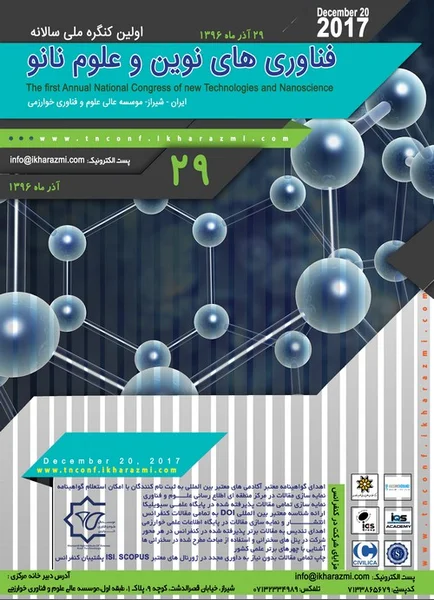-
effectively exerting the reinforcement and self-healing of polyvinyl alcohol hydrogel nanocomposite via physically functionalized graphene oxide for biomedical applications
جزئیات بیشتر مقاله- تاریخ ارائه: 1396/09/28
- تاریخ انتشار در تی پی بین: 1396/09/28
- تعداد بازدید: 432
- تعداد پرسش و پاسخ ها: 0
- شماره تماس دبیرخانه رویداد: -
hydrogels mimic native tissue micro- environment due to their porous and hydrated molecular structure [1][5]. an emerging approach to reinforce polymeric hydrogels with different nanoparticles and to include multiple functionalities focuses on incorporating nanoparticles within the hydrogel network to obtain superior properties and tailored functionality with emphasis on biomedical and pharmaceutical applications [10]. nano poly(dopamine)-treated graphene oxide/poly (vinyl alcohol) (“dg-o/pva”) nanocomposite hydrogels were made and characterized in this article via different tests including sem, mechanical and self-healing test, ftir and self-healing test. g-o was modified with nano poly(dopamine) in aqueous solution. a combination of hydrogen bonding, strong adhesion of nano poly(dopamine) at the interface of pva and g-o sheets, and reinforcement by g-o resulted in increase in self-healing and mechanical properties including tensile modulus, ultimate tensile strength, and strain-to-failure by 29, 80, and 69%, respectively, at 0.75wt% dg-o loading of the pva as a result of increased interfacial interactions between pva, poly(dopamine) and g-o along with significant self-healing that makes it suitable to be applied as a wound dressing and drug carrier to release different types of medicine in the next step of this research.
مقالات جدیدترین رویدادها
-
استفاده از تحلیل اهمیت-عملکرد در ارائه الگوی مدیریت خلاقیت سازمانی و ارائه راهکار جهت بهبود
-
بررسی تاثیر ارزش وجوه نقد مازاد بر ساختار سرمایه شرکت های پذیرفته شده در بورس اوراق بهادار تهران
-
بررسی تأثیر سطح افشای ریسک بر قرارداد بدهی شرکت های پذیرفته شده در بورس اوراق بهادار تهران
-
بررسی تأثیر رتبه بندی اعتباری مبتنی بر مدل امتیاز بازار نوظهور بر نقد شوندگی سهام با تأکید بر خصوصی سازی شرکت ها
-
تأثیر آمیخته بازاریابی پوشاک ایرانی بر تصویر ذهنی مشتری پوشاک ایرانی (هاکوپیان)
-
طراحی یک سیستم اتوماتیک مبتنی بر تشخیص و خواندن دقیق پلاک فارسی خودروها
-
توسعه پایدار در معماری بازارهای سنتی (مطالعه موردی: بازار سنتی کرمانشاه)
-
اثر پروبیوتیک، پری بیوتیک و سین بیوتیک بر پاسخ ایمنی همورال جوجه های گوشتی
-
اثر اندازه ساچمه بر عملیات مکانیکی تدریجی سطحی در فولاد زنگ نزن آستنیتی
-
transient and steady-state nanoindentation creep of polymeric materials
مقالات جدیدترین ژورنال ها
-
مدیریت و بررسی افسردگی دانش آموزان دختر مقطع متوسطه دوم در دروان کرونا در شهرستان دزفول
-
مدیریت و بررسی خرد سیاسی در اندیشه ی فردوسی در ادب ایران
-
واکاوی و مدیریت توصیفی قلمدان(جاکلیدی)ضریح در موزه آستان قدس رضوی
-
بررسی تاثیر خلاقیت، دانش و انگیزه کارکنان بر پیشنهادات نوآورانه کارکنان ( مورد مطالعه: هتل های 3 و 4 ستاره استان کرمان)
-
بررسی تاثیر کیفیت سیستم های اطلاعاتی بر تصمیم گیری موفق در شرکتهای تولیدی استان اصفهان (مورد مطالعه: مدیران شرکتهای تولیدی استان اصفهان)
-
کاهش اثرات مخرب زیست محیطی در طراحی داخلی اماکن تجاری ایران
-
بررسی و تحلیل نقدهای فمینیستی ادبیات کودک و نوجوان در نشریه تخصصی کتاب ماه کودک و نوجوان (1376-1393)
-
طراحی رویداد در فضاهای شهری با رویکرد به مکان سازی خلاق
-
phytochemical screening and antibacterial activity of the ethanolic stem bark extract of eucalyptus camaldulensis
-
earning management, corporate governance and corporate social responsibility disclosure: evidence from indonesia




سوال خود را در مورد این مقاله مطرح نمایید :